



Extremadura,
Spain Travel & Accommodation Guide
Cáceres
Hotels, Extremadura, Spain
|


Buy
at AllPosters.com

| CÁCERES
FEATURED HOTELS, EXTREMADURA, SPAIN |
|

| Cáceres
- capital
of Cáceres province in Extremadura. Products of cork, leather, pottery,
and cloth are made there. Cáceres was an important Roman colony.
It fell to the Moors in the 8th century but was recaptured (1229) by Alfonso
IX. The old town, on top of a hill and encircled by turreted walls, has
many notable Roman and Moorish structures. |
 |
 Search
for hotels in Cáceres and surrounding areas
Search
for hotels in Cáceres and surrounding areas
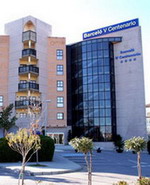 |
Hotel
Barcelo V Centenario, Cáceres
The modern Hotel Barcelo
V Centenario is set in a quiet residential area, two kilometres from Caceres'
historic centre with its squares and palaces, in northern Extremadura.
The Medieval Quarter of Caceres is two kilometres away and the Los Barruecos
nature reserve is 10 kilometres from the hotel. Guests can enjoy a dip
in the outdoor pool with its separate children's area. The pool is bordered
by a terrace where barbecues are held during the summer months. Business
guests are well catered for with a business centre and fully-equipped conference
rooms with capacity for up to 600 delegates. The hotel's a la carte restaurant
offers a fusion of modern Spanish and regional Extremaduran dishes and
has a wide selection of Spanish wines, while Las Americas serves Spanish
and international dishes and healthy eating options. The hotel's
informal bar overlooks the gardens where guests can enjoy a pre-dinner
drink or have a light snack, pastry or tapas. |
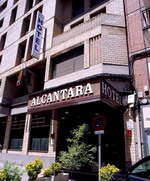 |
Husa
Alcántara, Cáceres
Located in the centre of
Cáceres, a few metres from the old quarter. We offer you our "Clavero"
restaurant where you can taste a creative and varied cuisine, together
with traditional Spanish products or renowned cheeses and wines made using
traditional methods. The hotel also offers a coffee shop, social
room, convention rooms and parking. The hotel offers 66 rooms, all
of them with complete bathroom facilities, colour satellite TV, Canal Plus,
mini-bar, air conditioning and heating. |
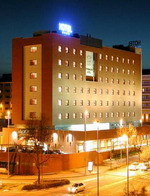 |
Sercotel
Extremadura, Cáceres
The Sercotel Extremadura
is located in Caceres, Spain, 500 metres from the city centre and 1.2 kilometres
from the ancient walled town centre. Caceres Train Station is 1.5 kilometres
away. This hotel has a garden, solarium, sauna, hot tub, and outdoor swimming
pool on site. Babysitting and childcare services are available. There is
wireless internet access throughout the hotel. Breakfast is available daily
at the Sercotel Extremadura. International dishes are served at the
Orellana Restaurant and there is an onsite bar and cafe. The 290
air-conditioned guestrooms have modern decor with warm tones, patterned
bedspreads, and wooden furnishings. Amenities include satellite television,
direct-dial phones, wireless internet access, minibars, and writing desks.
Marble bathrooms offer hair dryers and complimentary toiletries. |
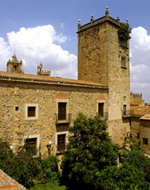 |
Parador
de Cáceres, Cáceres
The ancient Torreorgaz Palace
is built on Arabic foundations with a linteled door and a Baroque coat
of arms. It is in the heart of the Cáceres's old town and artistic
centre, which has been declared a World Heritage Site. This 14th Century
Parador, overlooked by its narrow tower, was founded by Diego García
de Ulloa, knight of the Order of Santiago. Gothic, Renaissance and Baroque
styles are reflected in the building and its surroundings. Its internal
courtyard, cobbled exterior, exposed wooden beams, and the lounge's original
mantelpiece make up the hotel's interior decoration. The bedrooms, decorated
in soft shades of cream are tasteful, spacious and comfortable. Rosemary
roast goat kid, merluza a la cacereña (hake dish), ancas de rana
a lo mozárabe (Arabic-style frogs’ legs), roast young lamb shank
with patatas a lo pobre (potatoes with green peppers and onions), and roast
suckling pig... Where do you begin? The hotel also has a wine-cellar
featuring more than 300 varieties of Spanish wine. |
Search
for more hotels in Cáceres and surrounding areas


| -
GUADALUPE FEATURED HOTELS/PARADORES |
|

| Guadalupe
- noted for its
monastery (formerly Hieronymite, now Franciscan) and the shrine of Our
Lady of Guadalupe, whose cult was transferred in the 16th century to Guadalupe
Hidalgo, Mexico. The area is still a pilgrimage center. |
 |

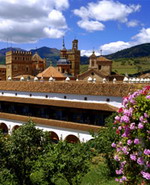 |
Parador
de Guadalupe, Guadalupe, Cáceres Province
The Hotel sits atop what
was the old 15th century San Juan Bautista Hospital and the former 16th
century Infantes or grammar school - important learning centres for medical
surgery and grammar respectively. The hotel is located in the old town
and has been declared a heritage site facing the world heritage site of
the town of Guadalupe. The garden - a true orchard of plants and
flowers -, the Gothic and Mudéjar cloisters, the secluded pool and
the large white-walled indoor spaces truly standout. Enjoy simple
local cuisine - Monastic cod, Extemadura ajo blanco (almond and garlic
gazpacho), Extremadura migas, Iberian sausages, lamb stew, chestnut pudding,
Guadalupe muégano cookie. Savour the simple local cuisine and bon
appétit! |

| -
JARANDILLA DE LA VERA FEATURED HOTELS/PARADORES |
|

| Jarandilla de la Vera
- Monumental
town with a castle and monastery, located approximately 230 kms from Madrid. |
 |

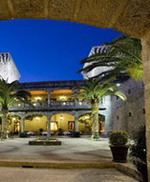 |
Parador
de Jarandilla de la Vera - Cáceres Province
The palace-castle lies sheltered
in the middle of the Vera and Tiétar valley, between gorges filled
with water, woods of chestnut trees and oak groves and stunningly beautiful
natural landscapes that reaffirm the richness of their historical, majestic
surroundings. For months it played host to an illustrious guest - Emperor
Carlos V. From the exterior the towers, the courtyard, the patio
de armas courtyard and its excellent swimming pool contrast with the olive
and orange trees. Inside you will find a relaxing and intimate atmosphere.
Enjoy the exquisite Extremaduran gastronomy: tomato soup, pucherete de
perdiz (partridge stew), lomitos de cordero asados a la miel de la dehesa
(honey roast lamb), migas extremeñas (garlic breadcrumbs) and, above
all, tarta de bellota extremeña con sus bomboncitos (acorn cake
with chocolate drops). |

| -
MONTANCHEZ FEATURED HOTELS/RURAL ACCOMMODATION |
|

| Montanchez
- in the middle
of three world heritage cities, Merida - Roman capital, Caceres and Trujillo,
ancient towns and homes of the conquistadors Cortes and Pizarro. The monastries
of Guadalupe and Yuste are close by. Visit the moorish castle of
Montanchez. |
 |

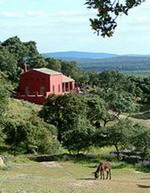 |
Finca
Al-manzil, Montanchez, Cáceres
Finca
Al-manzil is an extensive farm on the slopes of the Sierrra de Montanchez
a beautiful area which is like going back in time. In the Cortijo, (farmhouse),
we have 5 rooms for guests furnished with antiques and original art, a
spacious dining room, sitting room and library. All the rooms have private
bathrooms and great views. There are terraces and a spring-fed swimming
pool. You may walk all over the finca in ancient paths, up to the high
peaks and over the sierra to the moorish castle of Montanchez. There
is a flexible choice of accommodation at the finca on daily or weekly basis.
We have three houses, the CORTIJO, the BARN and CASA ALFARERA. |

| -
PLASENCIA FEATURED HOTELS/PARADORES |
|

| Plasencia
- is a walled market
city in the province of Cáceres. The focal point of the old
city is the market square (Plaza Mayor), where a weekly tax-free market
has been in operation every Tuesday since the foundation of the city. |
 |

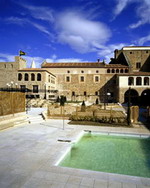 |
Parador
de Plasencia, Plasencia, Cáceres Province
The hotel is in the former
15th-17th century convent of Sto. Domingo, founded by the Zúñiga
family in the mid 15th century, in the Gothic style inside and in part
of the exterior. Strategically located in the historic centre of
Plasencia, this is the ideal place to explore the architectural beauty
of this singular city and the beautiful landscape around it. Try the exquisite
cooking of Extremadura: Potato soup, partridge stew, lamb with local honey,
compote of figs from La Vera, and the famous migas. During your next stay
in Plasencia, don't miss our night bar - A place to have conversation with
friends, to feel well with your partner, a space to find relaxation.
We have selected the best jazz music, both instrumental and vocal; a warm
and soft illumination with dozens of candles and a selection of the best
beverages together with the best service. |


| Caceres,
Extremadura, A Walled Renaissance Town by Nick Nutter
Top
/ Caceres Hotels
In the centre of Extremadura,
in Spain, is Caceres. A World Heritage Site since 1986 and declared a Place
of Historical Artistic Interest, by Royal decree no less, in 1949, it held
the promise of great things; and provided them, although not entirely what
was expected.
As you approach the old town,
sat on the highest point of course, you will notice the warm yellow sandstone
walls that totally encircle the hill. There are only three gates breaching
the walls that allow access to vehicles and pneumatic stumps guard each
one, the modern version of the portcullis. For the pedestrians there are
another four gates through the well-maintained perimeter. For those who
like a little trek then a walk around the interior base of the walls will
take about one hour and gives you the opportunity to admire the twenty-two
fortified towers. This is worth doing because it gives you a realistic
idea of the size of the place, not very large. Yet this area is crammed
with about seventy buildings, palacios, churches, museum and casas that
the tourist board encourage you to visit.
| You will probably find yourself
in the large and imposing Plaza Mayor, which is just outside the walls
and, from its cafes and restaurants, offers a fine view of the town. This
plaza is 'the' place to be in Caceres and it is around here that you will
find the restaurants. The local specialities include suckling pig and goat.
Wandering through the narrow,
claustrophobic streets, it is virtually impossible to get lost, even if
you do use the tourist map. What do you see? Monumental buildings, but
no humble abodes. Where did the peasants live? What exactly has happened
with this town? Another thing may strike you, the building style; it's
all relatively modern, well après 1450, no medieval, no Arabic,
certainly no Roman. And what about the sinister statue of a hooded figure
carrying a cross alongside a desiccated monk with a leper's bell just outside
the walls?
Suitably intrigued it was
time to find the answers to these questions. As ever the best place to
start was the museum, which is situated in the Casa de las Veletas o los
Algibes, a bit of a mouthful, but it is the large building right at the
top of the old town. There exhibits take you from the Paleolithic, through
the Neolithic, Megalithic, copper, bronze and iron ages and, hardly pausing
for breath, into the Roman period. The Romans did have a town here; they
called it Norba Caesarina, although nothing now survives of it. |

Buy
at AllPosters.com
|

The Arabs similarly were
here but, with one notable exception, little remains from their time either.
The exception is the cistern below the museum, still storing water, it
is a monument to Arab ingenuity.
The puzzle as to why this
town seems to start in the mid 15th Century is then explained. In 1229
King Alfonso IX took the town from the Arabs. The Christians who ripped
down virtually every building in the place retained it. They then built
the walls to defend themselves from the Arabs who, occasionally over the
next couple of hundred years, tried to get it back. The town became a free
trade centre and was soon full of merchants and then aristocracy all trying
to outdo one another with fine buildings. In 1476 Fernando and Isabel ordered
most of the town to be demolished to stop the continuous jostling for power.
One group of buildings that
did survive is tucked away beneath the city walls and is the old Jewish
quarter now called the Barrio de San Antonio. The Jews were moved outside
the walls in 1478 to a new area around Calle Pintores, near that horrific
statue in fact. In 1479 there were 130 Jewish families in the city, a considerable
proportion of the population of 2,000. By 1493 there were none, all having
been expelled from Spain, or worse.

Buildings
in a City, Caceres, Caceres Province, Extremadura
Buy
at AllPosters.com
After a few years to let
the dust settle, the aristocratic inhabitants of Caceres started building
again, each palacio or casa more imposing than the last. So most of what
you see is from this period that only lasted until around the end of the
16th Century by which time the riches from the Spanish colonies were drying
up. Caceres then slept undisturbed for 300 years untouched by events around
until, in 1949 the place became Spain's first listed heritage city.
So, the real Caceres. It
is a city that was built to satisfy the vanity of a few noble families
who deliberately removed all presence of what had gone before. People of
lower orders were removed or kept outside the walls. It was, for its introverted
inhabitants, a fantasy existence that offers the visitor today an opportunity
to appreciate the vast gulf between the 'haves' and the 'have nots' during
the 15th and 16th Centuries. You could imagine the atmosphere of the place
being similar to the Queen's Court in 'Alice Through the Looking Glass',
a total disregard for reality. But then, those nice yellow sandstone walls
were actually maintained to keep reality on the outside and they still
work.
Top
Caceres
Hotels
|
| About the Author - Nick
is the editor of a magazine on the Costa del Sol, Andalucia
Life |
|


|

